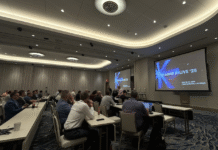
“People will forget what you said, people will forget what you did, but people will never forget how you made them feel.” — Maya Angelou
With these words from American poet, memoirist, and civil rights activist Maya Angelou Shereen Bhan, the managing editor of CNBC-TV18 introduced Piyush Pandey at the Delhi book launch of his latest book, Open House with Piyush Pandey on the evening of 29 April at the Taj Mahal Hotel in New Delhi. Both Pandey and Bhan are icons in their fields.
The book, published by Penguin India, is out in May at leading bookstores and eCommerce websites. The launch was sponsored by HSBC, and was part of its Rendezvous series on literary conversations, in association with Taj Hotels. HSBC has been in the banking business for more than 165 years and has come a long way since its inception in 1865.

Bhavna Mehta from the Taj Mahal welcomed the open house to the event. This was followed by Milee Ashwarya, editorial director at Ebury India, and Random Business acquainting the audience with Pandey’s work which primarily focuses on the ethics of advertising, client relationships, industry experiences, and the nuances of sensitive research.
Advertising as a cultural phenomenon
Who can forget the iconic Cadbury’s dancing girl on the cricket field ad that resonated with a generation of youngsters for the unabashed portrayal of reckless romance? Or ‘Mile sur mera tumhara’ patriotic anthem that united Indians of all ages, faiths, and regions? Or the Asian Paints ‘Har ghar kuch kehta hai’ campaign that brought it to the forefront of the industry? The leitmotif among these exceedingly successful advertisement campaigns is impactful storytelling which strikes a chord in the hearts of viewers.

Pandey is a veteran in the field of advertising and has been associated with the advertising agency Ogilvy for over four decades. He is currently the global chief creative officer at the firm. Pandey’s upbringing in the pink city left a deep impact on the masterful storyteller and inspired him to come up with campaigns that win people’s hearts and land people at crossroads of nostalgia even after years. He fondly recollects hearing the phrase dil jeet lo from elders while growing up, an adage that he has stayed faithful to ever since he began making sense of the world.
Pandey shared that the ‘secret ingredient’ of his signature style is understanding human beings and finding a common pulse that invokes a key emotion from the navrasa or the nine emotions that find eminence in Indian aesthetics, amid a particular region, language, or religion. He vehemently opposes the notion of translating cultural nuances to suit all requirements. Another hallmark of Pandey’s advertorial legacy is going sans taglines, a strategy that finds a mass following among marketing gurus globally.
He further says that advertising is not a one-man show and requires a team effort from brainstorming and ideation to aesthetic filming and soundtrack creation to ignite ‘the magic within.’ According to him, advertising is a two-way street in which the consumer either rejects you right away or embraces you with open arms. Another thing he stressed during the discussion was staying true to both the brand’s and people’s belief in you because when ‘value creation’ becomes the focal point of advertising it’s a win-win situation for all!
Pandey openly admonished theoretical research and encouraged the gathering to scratch beneath the surface while emphasizing the cruciality of sensitive research. Data-based research cannot be used as crutches for impactful storytelling, he said.
His inspiration to ‘move’ people comes from diverse sources – from interacting with total strangers over the course of a long train journey to a chance encounter with a maali or subziwala, he believes every person has the power to leave the deepest emotional impact. Talking about his love affair with advertising, Pandey concludes that sparking a thought, inspiring people, and building it is the way forward in the ad world.
















